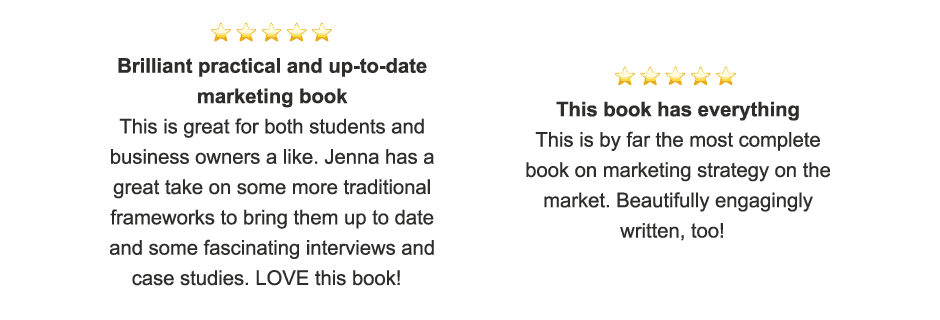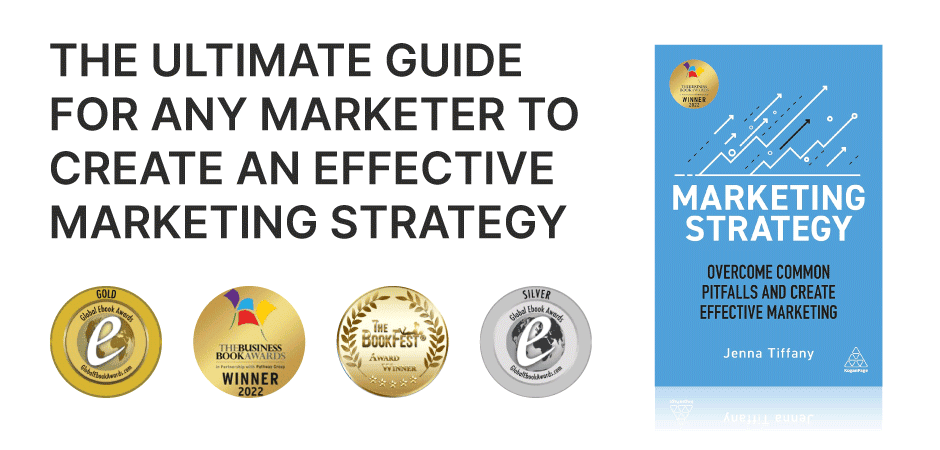In this blog, we’re going to be looking at how to effectively analyse the marketing environment.
Detailed and specific market analysis is the backbone of a successful marketing strategy. It will arm you, the marketer, with the kind of knowledge and self-awareness that can provide serious competitive advantage.
Sounds good? It is! Let’s dive in.
What is the marketing environment?
The ‘marketing environment’ is the S of the STRATEGY framework: Scenario.
A marketing environment is the scenario you’ll be working within. It’s the wider situation/context within which your marketing occurs.
You can broadly divide the marketing environment as a whole into two sub-environments: the micro and the macro.
The micro marketing environment
The micro marketing environment is comprised of internal factors (if it helps you to remember, think mIcro, with an I, for Internal). As Jenna put’s it in the book, ‘Marketing Strategy’:
"The micro marketing environment consists of the factors which affect an organisation internally, and the resources which help it to respond to these factors” .
(Tiffany, 2021)
Examples of micro environment factors include:
- Team skills
- Financial resources
- Intellectual property
- Supplier relationships
- Brand reputation
The macro marketing environment
The macro marketing environment consists of external factors, over which the organisation has little to no control. Examples of macro environment factors include:
- The state of the economy
- Current events
- Political issues
Remember that ship that got stuck in the Suez Canal in 2021? Companies all over the world are reliant on materials coming through the Suez Canal. The 6 day blockage caused huge delays to trade estimated at $10billion worldwide. Marketers had to work overtime to get the right messaging out to impatient customers (Glanz & Yee, 2021).

Image source: (Glanz & Yee, 2021)
The Suez Canal situation was a macro environmental factor over which companies had no control. However, as with all macro factors, the right knowledge helps marketers to pitch our messaging well and achieve positive outcomes for our brands.
What are the benefits of analysing the marketing environment?
Knowledge is power. Or, at the very least, knowledge will give you a strong competitive advantage.
By analysing the marketing environment, you arm yourself with a strong understanding of what your customers want, what your customers need, and how you can best deliver these.
A detailed analysis will also put you way ahead of the competition. Evaluating your own micro environment next to that of your competitors will give you valuable insight into your comparative strengths and weaknesses. You can then work up a strategy that combates your weaknesses and makes full advantage of your strengths while simultaneously providing value that your competitors cannot.
Regular analysis also helps you to spot patterns and trends that you can use to optimise your marketing.
So, what should you consider when analysing your marketing environment?
Here are the key questions to focus on answering within your marketing environment analysis:
- Where is the business now, and where would you like it to be?
- What is changing in the macro environment?
- What is changing in the micro environment?
- Who are your key competitors?
- Who are your audience?
- What trends and patterns can you spot in the macro environment?
- What strengths can you draw on to set yourself apart from your competitors?
It can help to frame these questions within four key models: SWOT, SWOTELL, PESTLE, and COMPETE.
Key models to use when analysing your Scenario
SWOT and SWOTELL are used to analyse the micro environment. PESTLE and COMPETE are for the macro environment. You can find a complete guide to these models in the book, ‘Marketing Strategy’, but here’s a quick rundown of how they work:
SWOT
SWOT is a time-honoured framework for analysing the micro marketing environment. It’s relatively simple: the acronym stands for Strengths, Weaknesses, Opportunities, Threats.
A good SWOT analysis will give your organisation self-awareness. It will clarify what you organisation and it’s marketing efforts are good at, what you need to work on, and how you can put your resources to good use in taking advantage of opportunities and dodging threats.
SWOTELL
The SWOTELL is an extension of the SWOT that are solely focused on analysing your organisation’s marketing efforts. The added ELL stands for Existing, Limitations, Leverage.
‘Existing’ refers to your existing marketing activity. ‘Limitations’ covers marketing-specific issues that may be holding your marketing back. And ‘Leverage’ helps to identify resources, strengths, and skills you can leverage to take your campaign to the next level.
PESTLE
PESTLE is a useful tool for analysing the macro marketing environment. The framework focused on these factors:
- Political
- Economic
- Social
- Technological
- Legal
- Environmental
By gathering and analysing relevant information on all of these factors, you can get a decent idea of how the macro environment is shaping up, and how macro factors could impact your marketing.
COMPETE
The COMPETE framework is designed to provide a comprehensive analysis of one of the most important aspects of the marketing environment: your competition.
COMPETE stands for:
- Current operators
- Offering
- Market share
- Price
- Expertise
- Target
- Employees
Through a COMPETE analysis, you can gain useful insights about your competition. These will help you to position your own offering, brand, and marketing in ways that give you a competitive advantage.
How to use SWOT, SWOTELL, PESTLE, and COMPETE
To help you to understand how to use these analysis frameworks, here are examples of what they look like in action:
SWOT/SWOTELL
Here is the SWOTELL analysis Jenna used when writing and marketing her book, ‘Marketing Strategy’:
| Strengths | Over 10 years’ experience and expertise to share. Client case studies – industry quotes/ perspectives. Easy to digest – actionable blueprint taking experience from communicating complex issues in an easy-to-understand way. Passion for the topic. |
| Weaknesses | First book – unknown as an author. As a result of no 1, it could be difficult to get reviews. Lots of marketing strategy books readily available which are already established as core course text books. Long-established existing concepts could make adoption of new approaches challenging. |
| Opportunities | To engage my network into my book. To establish the book as a core text for marketing and strategy courses. For the book to showcase expertise and agency services. Self-publishing has low barrier to entry and publishers regularly seeking new commissions. |
| Threats | Idea/format could be copied. There’s only me writing the book – sole author. Other projects for business may get in the way. Numerous books on the market about similar topic. |
| Existing | Current marketing activity consists of speaking at events, authoring whitepapers, blogs and articles, training, teaching and promoting across social media, with partners and on company website. |
| Limitations | Limited resources that are focused on consulting with clients. Heavy dependence of the book’s promotion on the author to be available. Excellent skills and experience available for the marketing activity of the book with the publishing team. |
(Tiffany, 2021)
Armed with this analysis, Jenna was able to effectively leverage the strengths and pivot the strategy to overcome the weaknesses. Focus was made on exploring opportunities identified, strengthen the limitations, and avoid any negative impact from threats.
PESTLE
Here’s the PESTLE analysis Jenna used for her book as an example:
| Political | Brexit could impact launching the book in European markets due to potential new tariffs (Informi, 2020). This may limit the number of countries where the book can be sold, ultimately reducing potential sales. |
| Economic | Fluctuations in the exchange rate between sterling, euro and dollar could impact the royalties I receive from each book sale. |
| Social | It is forecast that the e-book market will be worth over $17m in 2021 (Statista,2020). This provides an opportunity to expand the readership and sales of the book to global markets as an e-book. |
| Technological | Changing all of the time – new adoption of tools, ie TikTok. E-book vs print format. Channels for book sales. Digital marketing spend is estimated to reach£14bn in the UK by the end of 2020(Statista, 2020). This growth in the use of technology in marketing will require a need for marketing strategist which this book supports. |
| Legal | Throughout the development of the book’s content, it was important to ensure that it abides by UK Copyright Law (UKCCS,2020). Any inclusion of third-party material must have been granted permission for reproductive use. Changes in the UK and EU trade agreement could mean that there are new laws to comply with when selling, promoting and distributing my book to the EU (at the time of writing, it was to still be agreed). |
| Environmental | Printing in greyscale and not full colour reduces the impacts to the environment which is how this book has been printed (Pacific Office, 2018). |
(Tiffany, 2021)
The enhanced situational awareness that PESTLE provided Jenna with the factors to focus on to successfully navigate what could have been a tricky marketing environment. This enabled Jenna to avoid all potential pitfalls, and steer the book into the bestseller lists.
COMPETE
Here is a COMPETE example, focused on a fictional fashion retailer called Lupini:
| Key findings - Competitor: Lupini | |
| Current operator | Website: www.notarealbrand.co.uk Are Lupini easy to imitate? Yes, easy to imitate their product line, but not easy to imitate their supply chain, infrastructure or brand presence. How many competitors are there in the UK? 10,621 clothing businesses in the UK in 2023. |
| Offering | What are Lupini providing? They specialise in mid-range fashion, with a core product base of 15000 products. What makes our product different to Lupini’s? We offer more boutique garments, with attention to detail that Lupini cannot match. Is there a cost or disadvantage to the consumer if switching to a competitor’s product? Our price is higher, which we believe is justified due to the superior quality of our offering. |
| Market share | How much market share does Lupini have? 10% of fashion online shoppers shop with Lupini (Statista, 2023). How much UK revenue do we generate in comparison to Lupini? £1.7 million revenue in 2022, £1.3 million revenue for Lupini in the same year. |
| Price | What is Lupini’s pricing strategy? They offer free delivery. Their cheapest product retails at £7.99 (sunglasses), rising to £115 at the most expensive (leather boots) Are there a range of suppliers available to produce the product? Lupini use factories in China to produce its products. Labour is cheap, but shipping can be lengthy and problematic. |
| Expertise | How long has Lupini existed? Lupini entered the market in 2017. Are they recognisable and well known? 72% of UK shoppers recognise the Lupini brand. |
| Target | Who is Lupini’s typical target customer? Lupini targets customers in their early 20s and 30s, roughly ages 21-40. They also have a teen range for customers aged 12-16. How easy is it for buyers to switch from Lupini? Very easy. Plenty of alternatives exist. |
| Employees | Are Lupini globally based? They typically sell in the UK, with production in China. Is Lupini’s workforce skilled and experienced? Yes, and the brand is growing fast after a recruitment drive that saw it acquire a lot of skilled staff from rival brands. |
As you can see, this COMPETE example provides a valuable overview of the competitive landscape that can be used to inform your marketing strategy.
Pulling it all together with VRIO
Having analysed your marketing environment, it’s time to apply what you’ve learned to your own offering. One of the best ways to do this is with the VRIO framework.
VRIO stands for:
- Value. Is what you’re offering of genuine value for customers?
- Rarity. How unique and exclusive is your product?
- Imitability. Can a competitor easily imitate your offering?
- Organisation. Are you well-organised enough to pull off the kind of campaign needed?
With VRIO, you can put together everything you’ve learned from your analyses and focus these insights onto your own specific offering. This will give you a useful foundation on which to build the rest of your strategy.
Exclusive offer, 20% off!


